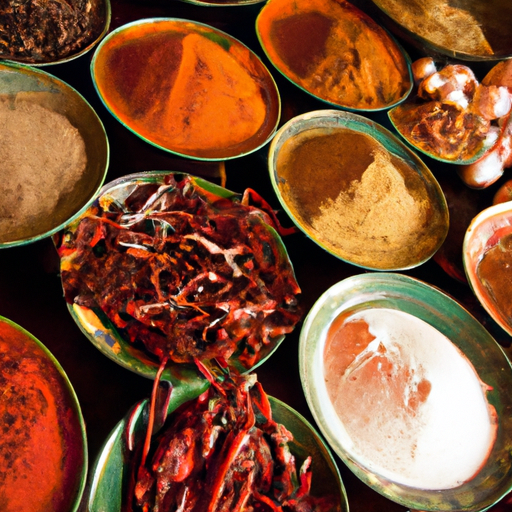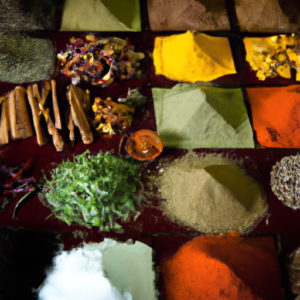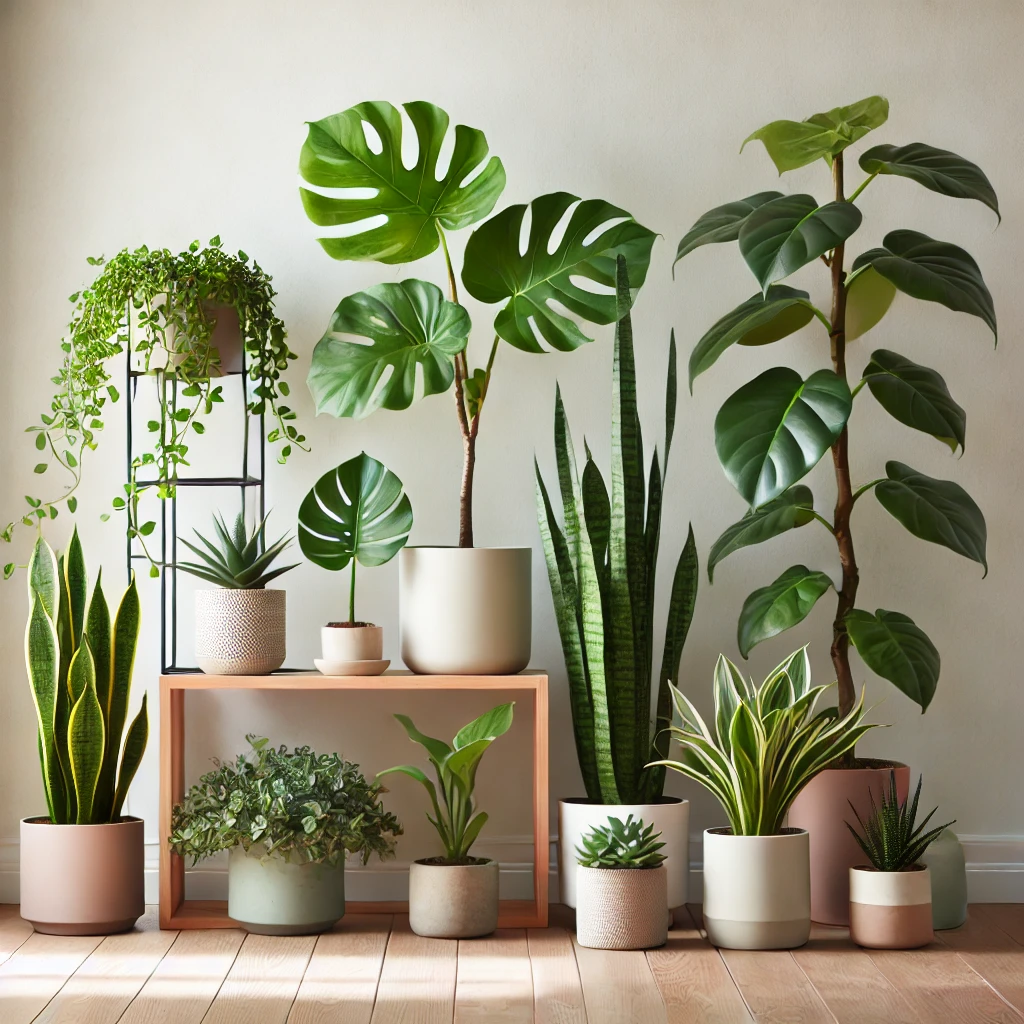In the bustling culinary world, where flavors and aromas reign supreme, “Herbs and Spices: From Farm to Table” is a must-have companion for both novices and seasoned chefs. This enticing product transports you on a delightful journey, immersing you in the fascinating realm of herbs and spices. Offering an array of tantalizing recipes, vivid illustrations, and intriguing anecdotes, “Herbs and Spices: From Farm to Table” unveils the secrets behind these aromatic ingredients, showcasing their origin, cultivation, and their transformative power in enhancing our culinary creations. Prepare to embark on a flavorsome expedition that will leave your taste buds tingling and your kitchen brimming with aromatic wonders.
1. The Importance of Herbs and Spices in Cooking
When it comes to cooking, herbs and spices play a crucial role in enhancing the flavor and aroma of our dishes. They have the power to transform a simple meal into a culinary masterpiece, adding depth and complexity to every bite. Not only do herbs and spices enhance the taste of our food, but they also contribute to its visual appeal by adding vibrant colors. Moreover, many herbs and spices are loaded with health benefits, making them an essential component of a well-balanced diet.
1.1 Enhancing Flavor and Aroma
Have you ever wondered why your favorite dishes taste so good? The secret lies in the herbs and spices used. Herbs like basil, parsley, and rosemary add a burst of freshness to your dishes, while spices like cinnamon, nutmeg, and cloves bring warmth and richness. These flavor enhancers work their magic by engaging our taste buds and olfactory senses. They can transform a bland dish into something extraordinary, making every meal a memorable experience.
1.2 Adding Color and Visual Appeal
Food presentation is an important aspect of culinary art, and herbs and spices can take it to the next level. Bright green herbs like basil and parsley not only add a pop of color to your plate but also make your dishes visually appealing. Spices like turmeric and paprika can add vibrant hues of yellow and red, making your food look as good as it tastes. By incorporating a variety of herbs and spices into your cooking, you can create visually stunning dishes that will impress your guests and elevate your dining experience.
1.3 Contributing to Health Benefits
Beyond their culinary benefits, herbs and spices also offer a range of health benefits. Many herbs and spices are known for their antioxidant properties, which can help fight inflammation and protect against chronic diseases. For example, rosemary is believed to boost memory and improve digestion, while cinnamon has been shown to regulate blood sugar levels. By incorporating these natural ingredients into your meals, you not only enhance the taste but also boost the nutritional value of your food, promoting a healthier lifestyle.
2. Types of Herbs and Spices
Herbs and spices come in various forms, each with its own unique flavor profile and culinary applications. Let’s explore some of the most common categories and their distinct characteristics.
2.1 Common Herbs
Common herbs are widely used in culinary practices around the world. These herbs are known for their fresh, earthy flavors and are often used as finishing touches or garnishes. Three of the most popular common herbs are:
2.1.1 Basil
Basil is a versatile herb with a sweet, slightly peppery flavor. It is commonly used in Italian and Mediterranean cuisines, where it adds a fresh, aromatic note to dishes like pasta, pesto, and salads. With its fragrant leaves and vibrant green color, basil is not only a delight for the palate but also a feast for the eyes.
2.1.2 Parsley
Parsley is a staple herb in many cuisines, prized for its mild, slightly bitter taste. It is often used as a garnish to add a pop of color and freshness to dishes. Parsley is also a key ingredient in sauces, dressings, and marinades, thanks to its ability to enhance the flavors of other ingredients.
2.1.3 Rosemary
Rosemary is a woody herb with a strong, pine-like aroma. Its robust flavor pairs well with roasted meats, potatoes, and vegetables, making it a popular choice for savory dishes. Rosemary can be used both fresh and dried, and its leaves can be easily stripped from the stem for convenient use in cooking.
2.2 Aromatic Spices
Aromatic spices are known for their strong fragrances and distinctive flavors. These spices add depth and complexity to dishes, often providing warming or sweet notes. Let’s take a look at three popular aromatic spices:
2.2.1 Cinnamon
Cinnamon is a beloved spice known for its sweet and warm flavor. It is commonly used in baking, particularly in sweet treats like cinnamon rolls and apple pies. Cinnamon can also be added to savory dishes, such as curries, to provide a hint of warmth and complexity.
2.2.2 Nutmeg
Nutmeg is a spice with a warm, nutty flavor and a slightly sweet aroma. It is often used in both sweet and savory recipes, such as custards, pies, and creamy sauces. Nutmeg can be used whole or ground, and a little goes a long way in terms of flavor.
2.2.3 Cloves
Cloves have a strong, pungent flavor that is both sweet and spicy. They are commonly used in baking, particularly in holiday recipes like gingerbread and mulled wine. Cloves can also be used to spice up savory dishes, such as stews and braised meats, adding a rich, warm undertone to the flavor profile.
2.3 Hot Spices
Hot spices are renowned for their fiery heat, capable of adding a spicy kick to any dish. These spices can range from mildly spicy to eye-wateringly hot, catering to different heat preferences. Let’s explore two popular hot spices:
2.3.1 Chili Pepper
Chili pepper is a staple in many cuisines around the world, known for its fiery heat and bold flavor. It can be used in both fresh and dried forms, with various levels of spiciness available. From mild paprika to scorching habaneros, chili peppers add a touch of heat and complexity to dishes like chili, salsa, and stir-fries.
2.3.2 Cayenne Pepper
Cayenne pepper is a hot spice made from ground dried chili peppers. It adds intense heat to dishes, making it a favorite among spice enthusiasts. Cayenne pepper is commonly used in spicy sauces, rubs, and marinades, providing a fiery kick that elevates the overall flavor of the dish.

3. Cultivating Herbs and Spices
Growing your own herbs and spices can be a rewarding experience, allowing you to have fresh ingredients at your fingertips whenever you need them. Here are some key steps to consider when cultivating herbs and spices.
3.1 Selecting the Right Location
Herbs and spices thrive in different environments, so it’s important to choose a location that suits their specific needs. Most herbs prefer full sun, while some spices, such as ginger, prefer partial shade. Take into account factors like sunlight, temperature, and humidity when selecting a location for your herb and spice garden.
3.2 Soil Conditions and Preparation
Preparing the soil is crucial for successful herb and spice cultivation. Most herbs and spices prefer well-draining soil that is rich in organic matter. If your soil is heavy or compacted, amend it with compost or sand to improve drainage and structure. Conduct a soil test to determine the pH level and make any necessary adjustments to create an ideal growing environment.
3.3 Propagation Methods
There are several methods of propagating herbs and spices, including seeds, cuttings, and division. Here’s a brief overview of each method:
3.3.1 Seeds
Growing herbs and spices from seeds can be a rewarding process, but it requires patience and attention to detail. Start seeds indoors in seed trays or pots, providing them with proper lighting and moisture. Once the seedlings have grown, they can be transplanted outdoors into your garden.
3.3.2 Cuttings
Propagation by cuttings involves taking a portion of an existing plant and encouraging it to root and grow into a new plant. Select a healthy stem or branch and make a clean cut just below a node. Remove any lower leaves and dip the cut end in rooting hormone before planting it in a pot or directly in the soil.
3.3.3 Division
Certain herbs and spices, like mint and chives, can be divided to create new plants. Carefully dig up the plant and separate the clumps into smaller sections, making sure each division has roots attached. Replant the divisions in suitable locations, ensuring they receive proper care and attention.
3.4 Watering and Fertilization
Proper watering and fertilization are essential for the healthy growth of herbs and spices. Most herbs prefer moderate watering, allowing the soil to dry out slightly between waterings. However, spices like ginger and turmeric require more consistent moisture. Fertilize your plants regularly with organic fertilizers, following the recommended dosage for each specific herb or spice.
3.5 Pest and Disease Management
Just like any other plants, herbs and spices can fall victim to pests and diseases. Monitor your garden regularly for signs of pests, such as aphids or caterpillars, and take appropriate measures to control them. Organic pest control methods, like companion planting and insecticidal soaps, can help keep your herbs and spices healthy. Additionally, practicing good sanitation and providing adequate air circulation can prevent the spread of diseases among your plants.

4. Harvesting and Storing Herbs and Spices
Knowing the right time to harvest your herbs and spices and understanding how to properly store them is crucial to preserving their flavors and aromas. Let’s explore the key steps involved in the harvesting and storing process.
4.1 Harvesting Herbs
Herbs are best harvested when they reach their peak flavor, just before they begin to flower. Different herbs have different harvesting techniques, but here are some general guidelines to follow:
4.1.1 Timing
Timing is key when harvesting herbs. Harvest early in the morning after the dew has dried but before the heat of the day. At this time, the essential oils that give the herbs their flavors are at their highest concentration.
4.1.2 Methods
Most herbs can be harvested by gently snipping the stems just above a leaf node. Use sharp, clean scissors or pruning shears to avoid damaging the plant. Harvesting from the top of the plant encourages bushier growth, so avoid excessive pruning from the bottom.
4.1.3 Drying
Drying herbs is a common method of preserving their flavors for future use. To dry herbs, tie small bundles of stems together and hang them upside down in a dry, well-ventilated area away from direct sunlight. Once the herbs are completely dry and crumble easily, store them in airtight containers away from heat and light.
4.2 Harvesting Spices
Spices are typically harvested when the plant produces fruits, seeds, or underground structures that are used for flavoring. The harvesting techniques vary depending on the spice and its specific plant part used. Here are some general guidelines for harvesting spices:
4.2.1 Picking at the Right Time
Spices should be harvested at the peak of their maturity to ensure optimal flavor. This may vary depending on the spice. For example, cinnamon is harvested when the bark of the tree is ready to be peeled, while nutmeg is harvested when the seed is fully mature and the husk starts to crack open.
4.2.2 Processing Methods
Processing spices often involves removing the outer husk, drying, and grinding the spice to the desired consistency. This can be a labor-intensive process, especially for spices like cloves, which require hand-picking to separate the buds from the stems. Once processed, store the spices in airtight containers away from moisture and direct sunlight.
4.3 Storing Herbs and Spices
Proper storage is essential to maintain the flavor and quality of your herbs and spices. Here are some key tips for storing them:
4.3.1 Proper Drying and Storage Techniques
After drying, store your herbs and spices in airtight containers made of glass or metal to retain their flavor and aroma. Keep them in a cool, dark place away from heat and moisture. Label the containers with the name and date of harvest or purchase to ensure freshness and easy identification.

5. The Journey from Farm to Table
Herbs and spices go through a fascinating journey from the farm to your table, involving various stages of processing, transportation, and distribution. Understanding this journey can give us a deeper appreciation for the efforts behind bringing these flavors to our fingertips.
5.1 Processing and Packaging
After harvest, herbs and spices undergo processing to ensure they are safe for consumption and ready for market. This can involve cleaning, sorting, drying, grinding, and packaging, depending on the specific herb or spice. Processing methods may vary depending on traditional practices, mechanized techniques, or a combination of both.
5.2 Transportation and Distribution
Once processed and packaged, herbs and spices need to reach their destinations efficiently and safely. The transportation process can vary depending on the scale of production, location of farms, and market demand. Local trade often involves shorter supply chains, ensuring a quicker journey from farm to table. In contrast, global trade may involve longer distances and more complex logistics.
5.2.1 Local vs. Global Trade
Local trade offers several benefits, including reduced carbon emissions, support for local economies, and the preservation of traditional farming practices. Buying herbs and spices from local producers can also provide a connection to the community and a deeper understanding of the origin of the ingredients. However, global trade allows access to a wider variety of herbs and spices that may not be locally available, providing opportunities to explore diverse flavors and culinary traditions.
5.2.2 Challenges and Importance of Efficient Supply Chain
Efficient supply chains are crucial for the timely delivery and quality preservation of herbs and spices. Challenges in the supply chain can include issues like improper handling, storage, or transportation, which can result in quality degradation or spoilage. Maintaining a well-functioning supply chain is vital to ensure that herbs and spices reach consumers in their freshest and most flavorful state.
5.3 Retail and Consumer Usage
Once herbs and spices arrive at retail outlets, they are ready for consumers to purchase and incorporate into their culinary endeavors. From home cooks experimenting with new flavors to professional chefs creating masterpiece dishes, herbs and spices play a key role in enhancing the taste, aroma, and visual appeal of a wide range of recipes.
5.3.1 Culinary Applications
Herbs and spices are essential ingredients in numerous culinary applications. From seasoning dishes, marinades, and dressings to infusing oils, vinegars, and beverages, their uses are virtually endless. The right combination of herbs and spices can elevate a simple dish to new heights, creating a symphony of flavors that tantalize the taste buds.
5.3.2 Medicinal and Ayurvedic Uses
In addition to their culinary applications, many herbs and spices are also used for their medicinal properties. Traditional systems of medicine, such as Ayurveda, often incorporate herbs and spices for their therapeutic effects. From calming chamomile tea to invigorating ginger-infused remedies, these natural ingredients have been valued for their ability to promote wellness and balance in the body.
In conclusion, herbs and spices are not just mere additions to our meals; they play a vital role in creating flavorful, visually appealing, and nutritious dishes. From the selection and cultivation of these natural ingredients to their journey from farm to table, every step contributes to the vibrant world of herbs and spices that we enjoy in our everyday cooking. So the next time you add a pinch of herbs or a sprinkle of spices to your dish, remember the love, care, and expertise that went into bringing those flavors to life.



